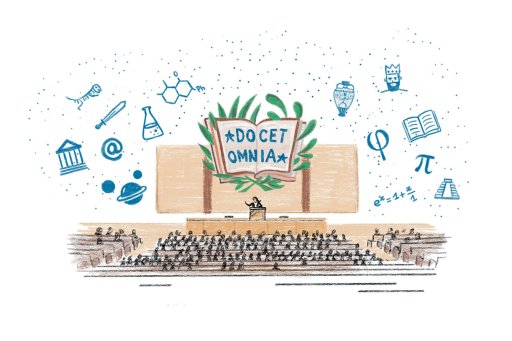Research Director at the Ecology, Systematics and Evolution Laboratory (Orsay) and member of the French Academy of Sciences, Tatiana Giraud studies the evolutionary mechanisms that enable organisms to diversify and adapt to their environment. Her research has led to a better understanding of the emergence of new plant diseases in natural and agricultural ecosystems.
For 2021-2022, she will hold the Biodiversity and Ecosystems Chair at the Collège de France, created with the support of the Jean-François and Marie-Laure de Clermont-Tonnerre Foundation.
At a time of environmental urgency, biodiversity needs more than ever to be factored into our equation for a sustainable future, but what exactly does it mean?
Tatiana Giraud: Biodiversity is the multiplicity of life forms. It's often understood as a number of species, and this is indeed an important component of biodiversity, but it's not just that, it's also the diversity within species. Within a single species, there are many differences between individuals and between populations, for example in terms of local adaptation to specific environments or resistance to pathogens [1]. An eloquent example of this is human skin color, which reflects adaptation to the level of sunlight in the various geographical zones we inhabit. All species are made up of populations that live in and adapt to different environments. Biodiversity is also a question of phylogenetic distance between species, i.e. when their last common ancestor was, from where they diverged and what adaptive traits they have acquired since that divergence.

How long has this notion been at the heart of the study of the living world?
Although the term "biodiversity" is relatively recent, dating back to the 1980s, what it refers to has long been a source of interest to mankind. Greek philosophers were already studying it, aware of its richness and importance. More recently, scientists such as Carl von Linné in the XVIIIth century took an interest in it for classification purposes. In 1859, Charles Darwin developed a theory to help us understand how populations diversified and became so well adapted to their environment: the theory of evolution by natural selection. With the science of ecology, it's the interactions within biodiversity that are studied. We understand that the living world is a complex system in constant motion, made up of functional relationships between individuals and species, diverse pressures and adaptation mechanisms. The disappearance of a large number of species disrupts these functional relationships and threatens ecosystems as a whole.
Global warming is a threat to biodiversity, but it's not the biggest immediate threat. What is?
If global warming reaches 4°C, it may become the primary cause of biodiversity loss, but to date it is effectively "only" the third culprit. At present, first place on the "podium" is the massive destruction of natural habitats, with urbanization, intensive agriculture and deforestation, among others. Observers can see that these practices are killing off all the species present locally. Secondly, we have the problem of overexploitation; we have, for example, emptied the oceans of their biodiversity through unsustainable fishing activities. Then there's pollution, in particular pesticides, which are spread on a massive scale. They are used to kill insects and fungi that ravage crops, but they kill all insects and microorganisms present in the environment, very effectively and indiscriminately. They are non-selective and designed to kill. They are the cause of the enormous decline in insects and, consequently, in birds. The last but not least threat I'd like to mention is that of invasive species, which is not necessarily well known to the general public. Through globalization and the worldwide movement of people and goods, we have introduced species into places where they were not originally found, sometimes with disastrous consequences.
What might these consequences be?
One of the first known cases was that of rats and snakes. When they arrive by ship on islands where they are not naturally present, they decimate the local species. Island ecosystems are known to be quite simple and fragile, with few large predators, so the slightest disturbance can be catastrophic. Birds, in our example, have not evolved to defend themselves against predators. So, when rats and snakes arrive in these ecosystems and start devouring eggs, the birds can't stop them, and end up seeing their population dwindle to the point of extinction. Then there are invasive plants that become hyper-dominant, displacing native species from their habitat and even causing their decline. Some have even been deliberately introduced! Such is the case of kudzu(Pueraria montana), which originated in the Far East and was intended to combat soil erosion thanks to its large roots. This very characteristic makes it dominant, and has enabled it to invade many areas, where it suffocates other plants, while becoming impossible to eradicate. Invasive species can be found in all groups: crayfish, gastropods, mussels, ants and, of course, pathogens, and the vector of biological invasions is very often human activity.

What means need to be deployed to defuse these threats and combat biodiversity loss?
It would be tempting to believe that we will always find a technological approach that will enable us to repair our mistakes. It's a bit like the myth of Icarus, where a chain of technological solutions to previous problems ends up creating new, even more serious problems. It might be reassuring to hope, for example, that genetically modified organisms (GMOs) and pesticides can save us from the consequences of climate change and emerging pathogens on our crops, when in fact these technological solutions impoverish crop diversity, which in turn facilitates the emergence of pathogens and reduces the possibilities of identifying new traits useful in the face of change. In reality, the sciences of ecology and evolution show that, on the contrary, the best tool for combating the danger of crop epidemics and global change is diversity: genetic diversity within species and diversity within species. We need to be able to think in terms of sustainable agriculture which, instead of exerting destructive pressure on biodiversity, includes it in its system. If we plant homogeneous hectares of the same plant clone, a pathogen will very quickly adapt to this clone and become capable of decimating the entire crop. On the other hand, if we manage the land by planting different species and varieties, we'll be better able to avoid their proliferation. In this case, a pathogen adapted to a certain variety will not be able to spread too quickly to the others, and the selection pressure for an emerging pathogen on each variety is reduced. Human societies need to realize this: if they continue with their current practices, the predicted decline in biodiversity will have serious consequences for human societies.

What consequences does this impoverishment of biodiversity have for human societies?
Human beings derive numerous benefits from biodiversity, known as "ecosystem services", and a whole branch of the sciences of ecology and evolution is devoted to their study. There are global services, such as the regulation of air through the storage ofCO2 by forests, the decline in which is having an impact on climate change; or the regulation of water through wetlands, which normally buffer the excess or shortage of water, and whose disappearance - attributable to both global warming and the decline in biodiversity - is causing an increase in the number of droughts and floods. Pollination is another such service, and the disappearance of insects, particularly pollinators, is being felt the world over. In China, some farmers have to pollinate their fruit trees by hand to obtain fruit, and in the USA, most fruit growers are obliged to keep bees, although they are now disappearing at such a rate that these compensatory practices are no longer sufficient. On the soil level, micro-organisms and earthworms are very important for renewal and fertilization, but the depletion of their populations forces us to use fertilizers, which worsen the process! Another example: at Chernobyl, there aren't enough decomposer organisms left, because they can't maintain themselves due to radioactivity. As a result, dead wood is no longer degraded and accumulates, leading to an increase in forest fires, which in turn increases the dispersion of radioactivity. And all this without mentioning the plant species that are disappearing, even though they may have contained active ingredients that we could have used to develop medicines to combat disease. One thing is certain: we are living through a mass extinction, and the poorer biodiversity becomes, the less it will be able to provide us with these services.

What are the concrete indicators that we are living through the sixth mass extinction?
The IPBES (Intergovernmental Platform on Biodiversity and Ecosystem Services) report has brought together a large number of scientific studies and expert opinions, enabling indicators to be constructed. In France, at the Muséum d'Histoire Naturelle, several teams have set up the Temporal Monitoring of Common Birds (STOC), based on the principle of participatory science. They have listening points all over France, manned by volunteers who note down the names of birds and the times at which they hear them. This enables them to track the evolution of these populations over time, and for several decades now. They have documented very rapid losses, both of species and of numbers within a given species. Similar monitoring is being carried out for insects, particularly pollinators, through which worrying declines are being documented.
How does this biodiversity balance work?
Biodiversity is a dynamic equilibrium. It's not static, like a stamp collection, and you can't conserve biodiversity by keeping a few individuals in a park. It is stable overall, precisely because it evolves and because the conditions necessary for its evolution are present. Let's take an image that's often used in evolution: that of the Red Queen in Lewis Caroll's book Through the Looking Glass. Alice runs with the Red Queen and sees that, despite her movement, the landscape around her does not move; she remains in the same place. The queen explains that she has to run to stay in the same place, and that if she wants to move forward, she has to run even faster, because the landscape is moving too. This is called coevolution, for example between hosts and pathogens. It may seem static, but in fact, everyone evolves to stay "in the same place", and it's diversity that fuels evolution. If we take the example of pathogens, each generation they evolve to be more virulent and the host evolves to be more resistant, but this is only possible thanks to diversity and environmental conditions. Reduced biodiversity creates a vicious circle, since it is important for the adaptive potential of species to local environments, which, when altered, in turn leads to reduced biodiversity. What's more, species are interdependent, and the disappearance of one can cascade into the disappearance of many others, which is difficult to predict. The more a species' abundance diminishes, the more its habitat is fragmented, the more the other species with which it interacts disappear, and the more the entire dynamic equilibrium is endangered. Paul Ehrlich's analogy of an airplane and its rivets can be used as an image of biodiversity and species: losing a few rivets is of no consequence to the plane, but beyond a certain number of missing rivets, the others jump out and the plane explodes in flight. We can't know the point at which this depletion will stop, and it will be too late when the ecosystem collapses, the species have disappeared and there's no turning back.

Interview by William Rowe-Pirra
Definition
[1] Pathogen: describes an organism, such as a fungus or bacterium, which can cause disease when it infects another.










